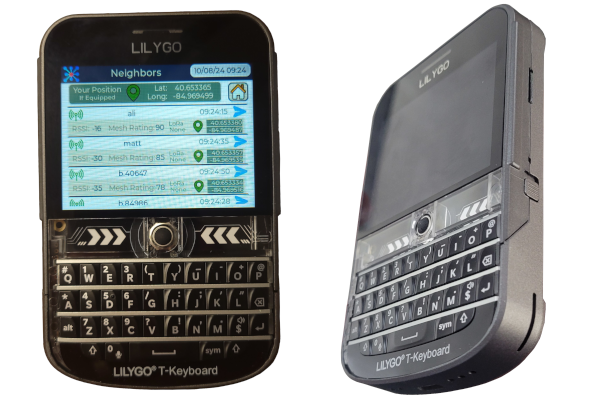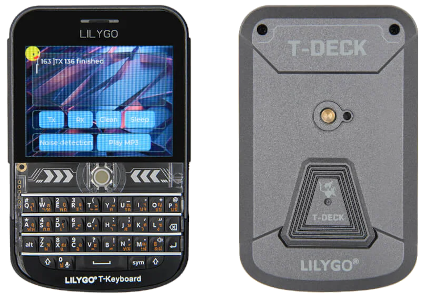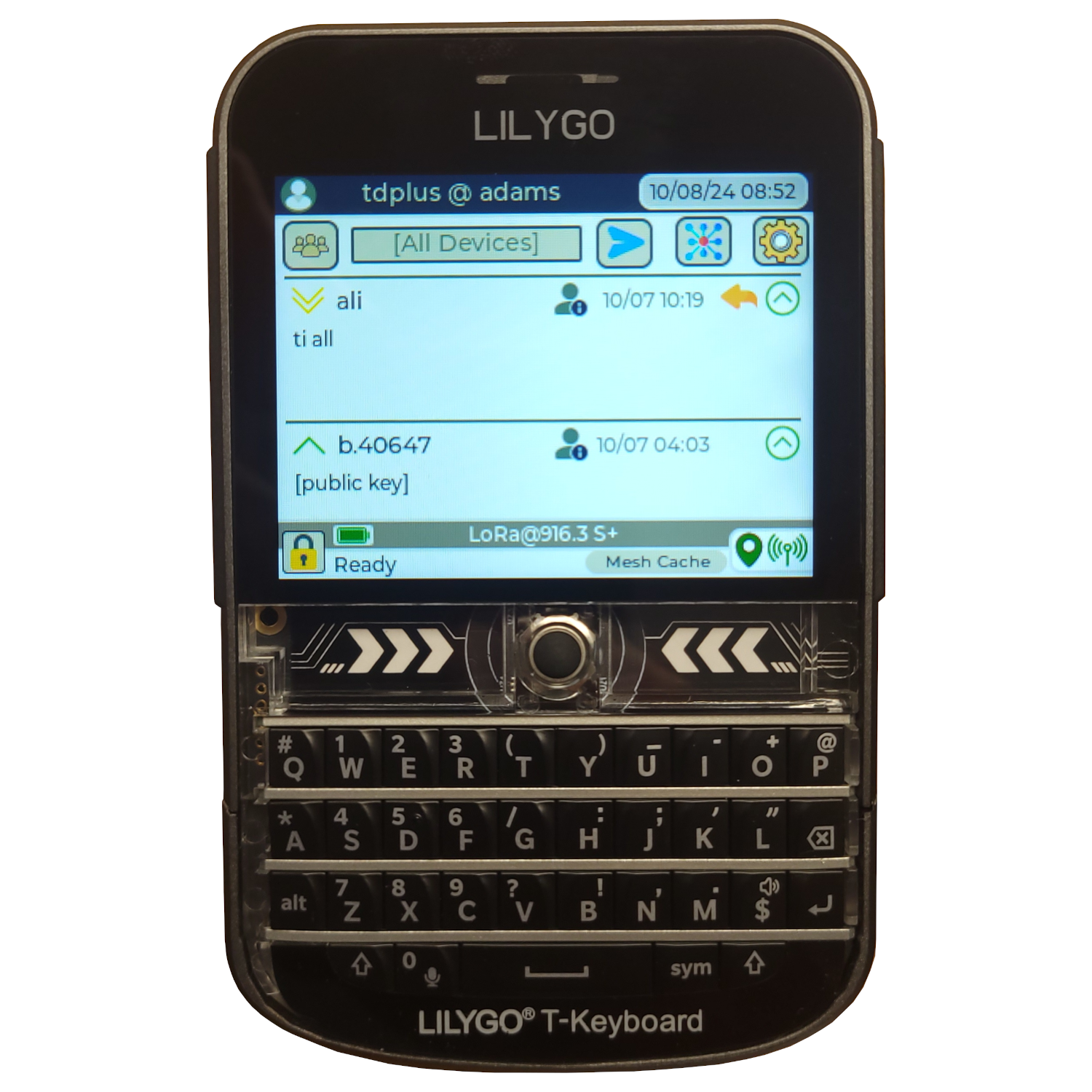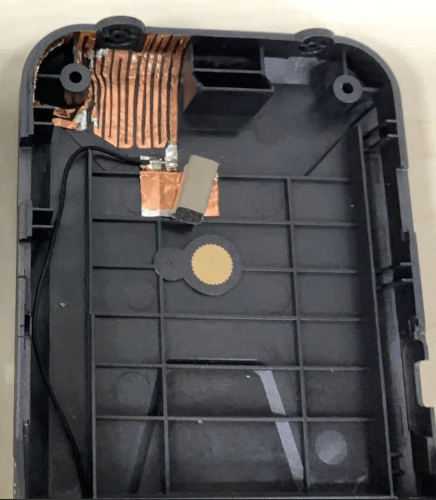lilygo T-Deck plus
Lilygo’s T-Deck Plus, introduced in late 2024, was a very interesting addition to their LoRa/mesh product lineup.
It is a fully assembled, pocket-sized device designed to run LoRa-based mesh communication firmware, and designed to be both developer and user-friendly.
Who is the T-Deck Plus For?
Being able to communicate off-grid is something you may not realize you need, until the moment you actually need it. Of course, by that point, it’s too late.
If you ever wander beyond the range of cell towers, experience impaired cell service, or just want to be sure your communications are private, you may want to get a grid-independent comms system.
There are multiple ways to do that, and the Rokland T-Deck Complete offers a very nice and very reasonably priced hardware solution to that problem.
build quality : Very Good
To fully test the Rokland unit’s usability and mesh communication capabilities, I installed our ChatterBox off-grid mesh comms firmware, which anyone can download for free.
Form Factor
The form factor of the T-Deck Plus is excellent. The unit feels very solid with tight tolerances. The case designed by Lilygo is a perfect fit for the T-Deck. This is where the T-Deck Plus really stands out against other similar devices, even ones that are based on the T-Deck Platform.
Ports and Switches
The power switch operates very smoothly. The reset button, I would say, operates too smoothly, because it’s a little too easy to accidentally bump the reset button. The USB-C port is easy to access.
Internal Antenna
For easy carrying and portability, the internal antenna is a perfect choice. I wasn’t quite sure what to expect performance-wise, but I’ve been pleasantly surprised, as you’ll see later on. For tan external connector, the T-Deck Plus has knockouts on top of the case allowing you to install an external SMA connector.
Random Keyboards
Hopefully you like surprises if you order the T-Deck Plus. The keyboard is always qwerty with the english alphabet, but you are likely to also have other characters on your keyboard, and there’s no way to know exactly what you’ll get until it arrives.
Usability : Very good - but don’t expect it to be quite like a mobile phone
Touch Screen
The IPS touchscreen is bright, easy to read, and responsive. Swiping works pretty much like you’d expect. Given the processor onboard is running at probably 1/10th the speed of your phone’s, some patience is warranted.
Trackball
With the ChatterBox firmware, the trackball is essentially what wakes the device up and makes it responsive (and do less background tasks). Scrolling works quite well with the trackball. It’s also a button you can press to navigate between screens.
Keyboard
In my opinion, the qwerty keyboard is one thing that really makes t-deck devices stand out. There’s no mistaking whether you’re on the right key or whether you’ve fully pressed it. It works great even if your fingers are cold or wet.
Responsiveness
There are limitations, given that you’re using a fairly low-power device with much less processing power and memory than a modern phone. However, it is capable of being acceptably responsive and quick enough for basic communication and location features.
My Test Setup
Base Station
This is a ChatterBox mesh E-Paper mini node, utilizing a 20 watt bi-directional amp and an 86” roof-mounted omnidirectional Signal Plus antenna. This setup (the amp) requires an amateur radio license in the US.
ChatterBox GPS Mesh Node
This ChatterBox GPS-enabled mesh node is sporting a well-tuned rubber ducky style antenna. The performance of this node should be similar to the Rokland’s, so I’d expect whatever distance we can achieve with would also be achievable between to Roklands.
This unit is not amped, so its performance should be quite similar to what you’d get with any basic node with a similar antenna. This setup does not require any special licensing to operate within the US.
I positioned this unit in a fairly good location, with regard to line-of-sight.
ChatterBox Mesh Solar Base Station / Node
This is a completely off-grid solar powered mesh node (no power required) that is occasionally available in the chatters.io mesh comms products store.
It’s a ChatterBox Mini Node (T3S3) inside a Rak solar enclosure. It ships with both a 15” omni fiberglass antenna (shown) and a smaller rubber ducky-type antenna for use as a mobile node.
For purposes of this test, I’m using the 15” omni antenna. I positioned this unit in a fairly good location, with regard to line-of-sight.
Results
Testing still in progress, more results coming shortly
Battery Life
Battery life was tested running the ChatterBox mesh firmware non-stop, which is how the firmware was designed to run for optimal meshing.
Typical Use: 16 hours
Infrequent Use: 24+ hours
Full Specs
Base T-Deck Dev Board
ESP32 S3FN16R8 dual-core LX7
2.4 GHz Wifi + Bluetooth 5 (BLE)
16 MB of Flash, 8 MB PSRAM
2.8” 320x240 Color IPS LCD
SX1262 LoRa Transceiver
Integrated keyboard and trackball
T-Deck Plus Finishing Touches
Lilygo-designed case
Internal antenna
2000 mAh battery
GPS module















